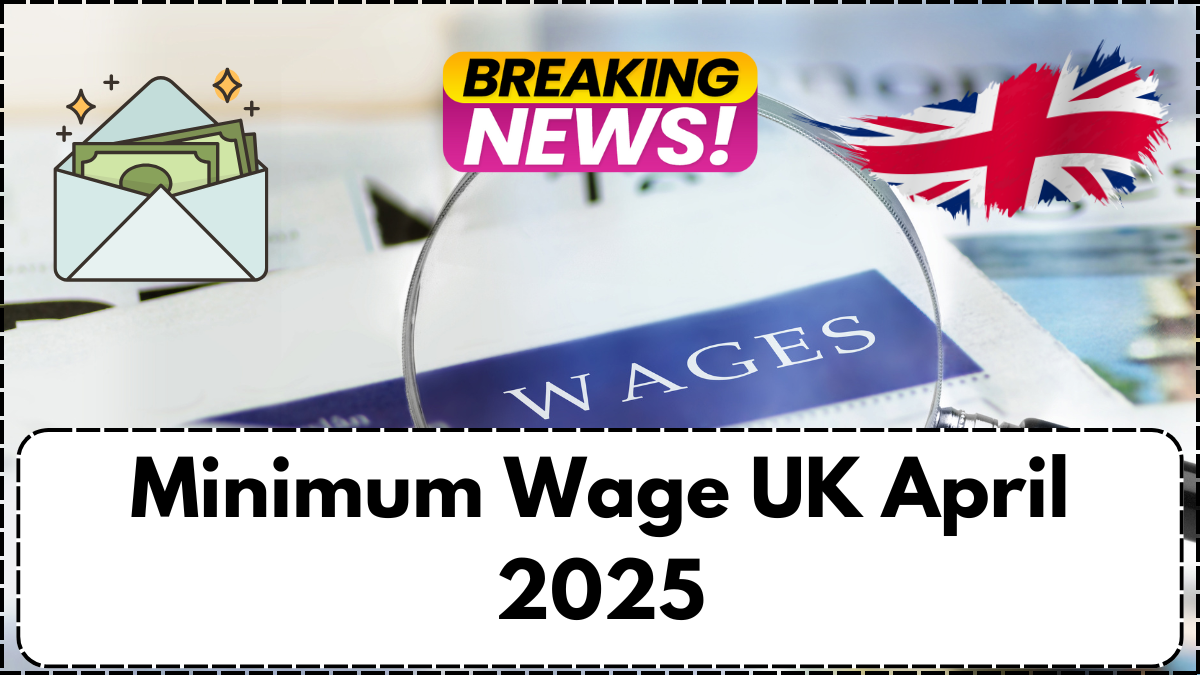Starting 1 April 2025, the UK Government will roll out a nationwide increase in minimum wage rates, a move aimed at countering inflation and easing the financial strain on workers amid rising living costs. The changes include a broader application of the National Living Wage (NLW) and notable pay boosts across younger age brackets—making it one of the most significant adjustments in recent years.

Expanded Eligibility for the National Living Wage
A major shift this year is the lowering of the age threshold for the National Living Wage. Previously, only workers aged 23 and over qualified. As of April 2025, the NLW will apply to anyone aged 21 and above, reflecting the government’s focus on reducing income disparities, particularly for younger full-time employees.
This expansion is expected to benefit thousands of 21- and 22-year-olds who were previously paid at lower youth wage rates, giving them an immediate financial uplift as they enter or grow within the job market.
Breakdown of the 2025 Minimum Wage Rates
The new minimum wage rates, effective from 1 April 2025, are detailed in the table below:
| Age/Category | 2024 Rate (£) | 2025 Rate (£) | Increase (£) | % Change |
|---|---|---|---|---|
| National Living Wage (21+) | £11.44 | £12.21 | £0.77 | 6.7% |
| 18–20 Year Old Rate | £8.60 | £10.00 | £1.40 | 16.3% |
| 16–17 Year Old Rate | £6.40 | £7.55 | £1.15 | 18.0% |
| Apprentice Rate | £6.40 | £7.55 | £1.15 | 18.0% |
| Accommodation Offset | £10.66 (daily) | £11.33 (daily) | £0.67 | 6.3% |
These increases mark the largest year-on-year wage hike for under-21s in over a decade. They are designed to close the pay gap across age groups, helping younger workers keep up with living expenses.
What This Means for Workers in April 2025
For a full-time worker aged 21 or older, the increase from £11.44 to £12.21 means a projected annual salary of around £24,441, up from £22,918. Here’s how this could impact workers:
-
Increased Take-Home Pay: More room in your budget to cover essentials like rent, utilities, and food.
-
Greater Financial Stability: Especially beneficial for part-time and hourly workers managing tight finances.
-
Progress Toward a Real Living Wage: Although many advocacy groups argue the rate still lags behind actual living costs in certain regions, this is seen as a positive step forward.
Implications for Employers and Businesses
While the new wage rates are a win for employees, they introduce fresh challenges for employers—particularly in labour-intensive sectors such as hospitality, retail, and care where many staff are on minimum wage contracts.
Key Concerns for Employers:
-
Increased Wage Bills: Especially difficult for small businesses operating with slim profit margins.
-
Pressure to Adjust Prices: To offset costs, some may need to raise prices on products or services.
-
Administrative Overhaul: Employers must ensure payroll systems and employment contracts reflect the new rates before April.
Compliance Checklist:
-
Review all wage agreements and employment contracts.
-
Update payroll software to reflect new rates by 1 April 2025.
-
Inform staff of changes in their pay structure.
-
Ensure no employee is underpaid—failure to comply can result in penalties up to £20,000 per underpaid worker, alongside reputational damage and legal consequences.
Government’s Objectives Behind the 2025 Wage Reform
This policy forms part of a broader economic strategy to:
-
Tackle wage inequality
-
Support low-income households, especially younger individuals facing financial insecurity
-
Stimulate consumer spending by boosting disposable income among lower-wage earners
By increasing pay for younger age groups and apprentices, the government aims to make employment more attractive and reduce reliance on state benefits.
How Employees Should Prepare
Practical Steps for Workers:
-
Check Your Payslip in April: Confirm your hourly rate reflects the new legal minimum.
-
Know Your Rights: If you suspect you’re being underpaid, contact Acas (0300 123 1100) or reach out to Citizens Advice.
-
Plan for the Extra Income: Use the pay bump to build an emergency fund, clear debts, or manage household costs more effectively.
Who Is Not Covered by the New Rates?
While most employees are eligible, the minimum wage rules do not apply to:
-
Self-employed individuals
-
Volunteers and unpaid interns
-
Members of the armed forces
-
Family members working in a family business within a private home
If you’re uncertain about your eligibility, consult your employment contract or seek advice from a legal expert.
Conclusion
The April 2025 UK minimum wage increase represents a significant shift in labour policy—especially for younger workers and apprentices. It reflects growing efforts to keep wages in step with inflation and living expenses. However, it also places the onus on employers to adapt quickly and stay compliant. For both employees and businesses, being informed and proactive is key to navigating this change successfully.
Frequently Asked Questions (FAQs)
Q1: When do the new minimum wage rates take effect?
A: The updated rates come into force on 1 April 2025.
Q2: Does the National Living Wage now apply to 21-year-olds?
A: Yes, from April 2025, anyone aged 21 and over is entitled to the National Living Wage.
Q3: What happens if my employer doesn’t update my pay?
A: You can report underpayment to Acas or HMRC, and your employer may face penalties.
Q4: Are apprentices paid the same as 16–17-year-olds now?
A: Yes, both groups will receive £7.55 per hour under the new 2025 rates.
Q5: Will this affect part-time workers?
A: Absolutely. All eligible workers—full-time or part-time—must be paid according to the new rates.
Akesh is a furniture expert with years of experience in design and craftsmanship. Specializing in sustainable materials, he shares his expertise to help people create stylish and functional living spaces.
